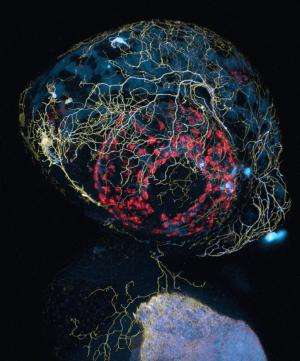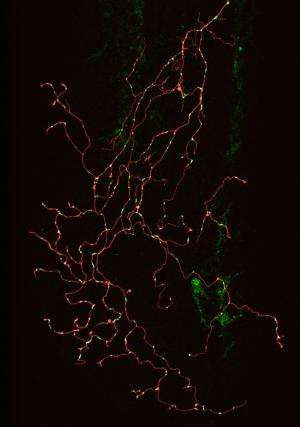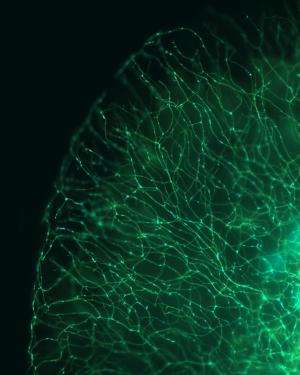See-through 'MitoFish' opens a new window on brain diseases

German scientists have demonstrated a new way to investigate mechanisms at work in Alzheimer's and other neurodegenerative diseases, which also could prove useful in the search for effective drugs. For new insights, they turned to the zebrafish, which is transparent in the early stages of its life. The researchers developed a transgenic variety, the "MitoFish," that enables them to see – within individual neurons of living animals – how brain diseases disturb the transport of mitochondria, the power plants of the cell.
Neurodegenerative diseases such as Alzheimer's, Parkinson's, ALS (amyotrophic lateral sclerosis), and MS (multiple sclerosis) are quite different in their effects on patients' cognitive and motor functions, behavior, and prognosis. Yet on the level of individual neurons, common mechanisms can be observed that either cause or accompany nerve degeneration in a number of different diseases. One of these is a disturbance in the transport of mitochondria, organelles that play several vital roles in the life of a cell—above all, delivering energy where it is needed. And in a neuron, an extremely power-hungry cell, that means moving mitochondria all the way down its longest extension, the axon. Studying mitochondria transport in other animal models of neurodegenerative disease, particularly in mice, has been revealing. But the MitoFish model opens up new possibilities.

The new model was jointly developed in the labs of Prof. Thomas Misgeld of the Technische Universität München (TUM) and Dr. Bettina Schmid, a senior scientist of the German Center for Neurodegenerative Diseases (DZNE) based at the institute of LMU Prof. Christian Haass. "This collaboration has provided a system," Misgeld says, "with which we can try to understand the traffic rules or the life cycle of a given organelle, in this case mitochondria, in the context of a nerve cell that's existing in its physiological environment, where it is developing and changing. Most of these things we don't understand well enough to model them in another setting, so we have the organism do it for us."
The MitoFish is both readily manipulated, enabling researchers to pose specific questions, and literally transparent—allowing non-invasive in vivo observation of changes relevant to disease processes. It is possible to image a whole, living neuron over time and to follow the movements of mitochondria within it. "The zebrafish is an established genetic model," Schmid explains, "which means you can bring foreign genes or certain proteins into a fish to test hypotheses about basic biology, disease mechanisms, or potential therapies. And because the early embryo is transparent, you can label specific nerve cells with a fluorescent protein and then look at them in an intact, living animal."

The researchers stress that this new window into the neurodegenerative diseases could not have been opened without combining complementary expertise: from Misgeld's lab, imaging and analysis focused on organelle dynamics; and from Schmid's lab, development of transgenic zebrafish models that are stable enough for long-term study. The first authors of the team's report in the Journal of Neuroscience are Gabriela Plucinska (TUM) and Dominik Paquet (DZNE). The collaboration leaders are linked through participation in the newly established Excellence Cluster SyNergy (Munich Cluster for Systems Neurology), as well as in the DZNE and the Excellence Cluster CIPSM.
"Just talking to each other," Misgeld recalls, "we realized that this would be a perfect match—that she would have situations in which the kind of trafficking question I wanted to look at could be of high relevance, and that she had all the tools we would need to carry this forward."
The driving force, they emphasize, is to understand more about Alzheimer's and other brain diseases to help steer the search for therapies in the right direction. "We need to understand how the machine works before we can operate it," Schmid says, "and modern biology is so technically advanced that no lab can be cutting-edge across the whole range of needed expertise."
More information: Gabriela Plucińska, Dominik Paquet, Alexander Hruscha, Leanne Godinho, Christian Haass, Bettina Schmid, and Thomas Misgeld. In Vivo Imaging of Disease-Related Mitochondrial Dynamics in a Vertebrate Model System. The Journal of Neuroscience, 32(46):16203-16212. DOI:10.1523/JNEUROSCI.1327-12.2012












